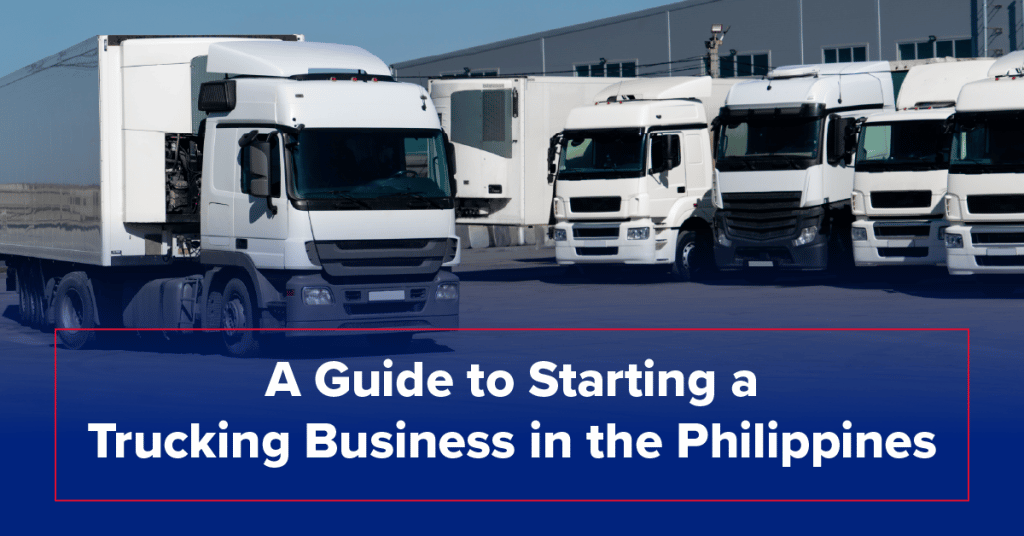Many businesses get to restock their shelves, deliver goods, and continue their business operations with the help of trucking businesses. Thanks to these truckers, local suppliers, manufacturers, and distributors get to transact with their clients regardless of the latter’s geographical location.
These days, customers can skip the long lines in physical stores and purchase goods online, thanks to e-commerce. That’s another industry where the trucking sector comes into play.
The trucking sector is a vital part of businesses’ logistics and supply chain processes—from production to distribution—making it a promising business venture. However, like any other enterprise, it presents potential roadblocks. It’s best to be as informed as possible on how to start a trucking business in the Philippines. On that note, let this infographic guide you along the way.
How to Start a Trucking Business in the Philippines
What is a Trucking Business?
A trucking business is part of the transport and logistic sector and may operate one or multiple vehicles. Its role is to deliver goods from sellers to buyers safely. These goods may be raw materials from suppliers, which manufacturers need.
They can also be consumer goods from online shops, transported to distribution centers where they are sorted out for dispatch.
5 Challenges in the Philippine Trucking Industry to Consider
It pays to know what obstacles might impede your business’s growth before starting it. Here are some notable trucking challenges to look out for.
1. Public road infrastructures
The government has been aggressive in its “Build, Build, Build” program. That means that there has been a significant development in the country’s road network. These projects make truck passages and route mapping a challenge.
Furthermore, the productivity of truckers may be hindered by certain areas of the Philippines that have old roads, traffic congestion, a lack of urban planning, and the maximum gross vehicle weight for the trucks.
2. Truck ban policy
Back in the day, trucks were allowed on EDSA. When the Land Transportation Franchising and Regulatory Board (LTFRB) deemed trucks contributors to heavy traffic. They were given a travel window due to this. That travel window eventually led to a total truck ban.
The truck ban applies from 6:00 a.m. – 10:00 a.m. and 5:00 p.m. – 10:00 p.m. daily with the exemption of Sundays and holidays. This truck ban policy is not exclusive to Metro Manila. You can see the list of the places where the truck ban is implemented here.
3. Oil prices and fuel taxes
Oil prices fluctuate. Factors that trigger oil price hikes include the peso-to-dollar exchange, demand and supply, and oil prices in the world market. The world market, in particular, is affected by global events.
For instance, the current conflict between Russia and Ukraine has significantly increased oil prices in such a short amount of time. Add this to the 2018 implementation of excise tax on fuel alongside the Tax Reform for Acceleration and Inclusion (TRAIN) Law, and you have a costly business scenario that you must account for.
Not to mention the hefty toll fees, which can accumulate to a significant amount if there are multiple trips a day.
4. The impact of COVID-19
While inoculation efforts have been becoming more prevalent, they do not mean the pandemic has successfully ended. Experts agree that another surge is not unlikely. If this happens, quarantine protocols or strict policies and guidelines can again affect shipping schedules and business prospects.
5. Truck acquisition and maintenance
Unless you apply for an auto loan, you might find it difficult to afford a new truck. You have the option to buy second-hand, but you have to ensure it passes roadworthiness tests conducted through the Motor Vehicle Inspection System (MVIS) by the Land Transportation Office (LTO).
While the truck age policy has been suspended, it remains imperative to ensure that your units are in good shape despite the vehicle’s age. New or second-hand, you will have to shoulder maintenance expenses that are part and parcel of the trucking business.
Steps to Starting a Trucking Business
Once you’re ready to start a trucking business, follow these steps.
- Create a trucking business plan
This is the blueprint of your business. It’s where you plot your objectives and the steps you plan to pursue to achieve those goals. At this point, you also decide which niche to focus on. Your options include courier, dump, delivery, truck leasing, and moving services, among others.
- Get ready to shell out capital
It may seem ideal to have saved enough money to fund your trucking business from out-of-pocket. However, financial assistance is available to seek from either investors or loan providers. For the latter, you may consider a trucking business loan from Asialink Finance.
- Choose the right trucks for your business
Again, you can either buy brand-new or second-hand trucks for your business. That decision will hinge on your working capital.
Consider your trucking niche when determining the dimensions and specifications of the truck you’ll choose. For instance, if you’re delivering perishable goods, your truck should double as a refrigerator, or at least it has to have enough space for a refrigerated compartment.
- Obtain proper insurance
Business insurance will protect not only your truck and its driver. It will also safeguard the goods under your care. Consider this a necessary expense because you’ll never know when accidents will happen. With insurance, your business will be tough enough to get going.
- Prepare necessary business licenses, permits, and requirements
Once you’ve crafted a plan and determined the best options for your trucking business, you’re ready to proceed with making this venture legal and official. Here are the documents you need to prepare:
- Request Letter addressed to the director of the Philippine Economic Zone Authority (PEZA)
- At least one Endorsement Letter from a PEZA company/client
- Notarized Application Form (from PEZA)
- Notarized Annex “A”-Anti-Graft Certificate
- Notarized Board Resolution
- List of employees with their positions
- Certificate of Registration from SEC or a Certificate of Registration from DTI
- BIR Clearance
- Mayor’s Permit
- Standard Schedule of Service Rates
- Remain compliant with government rules and regulations
Keep abreast of government policies, such as truck bans and quarantine protocols. Follow them strictly so that you do not overstep the bounds of law and be penalized.
5 Essential Trucking Business Tips
To succeed in your trucking business, here are some tips worth considering.
- Determine your niche
Do not try to be everything to your clients. Pinpoint which market niche you can handle at your best and stick with it. If you think you’re most suited to delivering consumer goods between sellers and distribution centers because you’re detail-oriented, follow through with that instinct.
You can also zero in on special cargos such as building materials and petroleum products. If you’re passionate about the agriculture and food sector, you can further navigate and learn a lot about the industry by being an agricultural transporter.
- Keep track of maintenance and expenses
Truck maintenance and other relevant costs are part and parcel of the business. However, it would be best if you were on top of those expenses so that you do not compromise profit margins.
For instance, if you’re operating a refrigerated compartment, expect to spend more on fuel compared to when you’re hauling dry goods. On top of such costs, you should also keep tabs on other expenses, including parts replacements, truck maintenance, and check-ups with your trusted mechanic. Account for these differences to allocate an adequate budget.
- Consider truck financing
In any business, there comes a time when things don’t work out as planned or when you need to expand. Either way, you will require financing to help fund your business needs. For example, when you need to add more trucks to your fleet.
Do not shy away from applying for online financing or tapping financial institutions for funding. Or alternatively, you may lease additional trucks, which will be cheaper compared to buying new ones.
- Build a solid client base
Be active in business gatherings. Give out as many calling cards as you can and reach out to companies you think can benefit from your logistics and transportation services. Remember that strangers are just clients you haven’t met yet. Or, if they’re not prospective clients, they may be viable leads.
- Run an efficient back office
The actual hauling of goods is just the end product of other functions you need to carry out, such as cargo inventory and scheduling. With an efficient back office, you will stay on top of business operations. - Be on time – Trucking is governed by strict schedules. Respect those schedules and deliver on time without fail. That’s what will set you apart from competitors.
Go Places
With a trucking business, you’ll go places if you’re guided with a foolproof business plan and aware of the challenges that come with this business venture. Keep updated with the latest trucking industry trends and meticulously research for the best business strategies.
If you know with certainty that you want to give this entrepreneurial opportunity a go, the next order of business is capital sourcing. Check out the products of one of the leading finance companies in the Philippines, Asialink Finance. They offer accessible loans with competitive rates. Jumpstart your dream of starting a trucking business in the Philippines and apply now.
- 7 Credit Score Myths DEBUNKED! - April 29, 2024
- How to Talk about Money with Your Partner: 7 Tips - April 24, 2024
- Truck Maintenance Checklist: 14 Ways to Keep Your Truck in Top Shape - December 20, 2023






